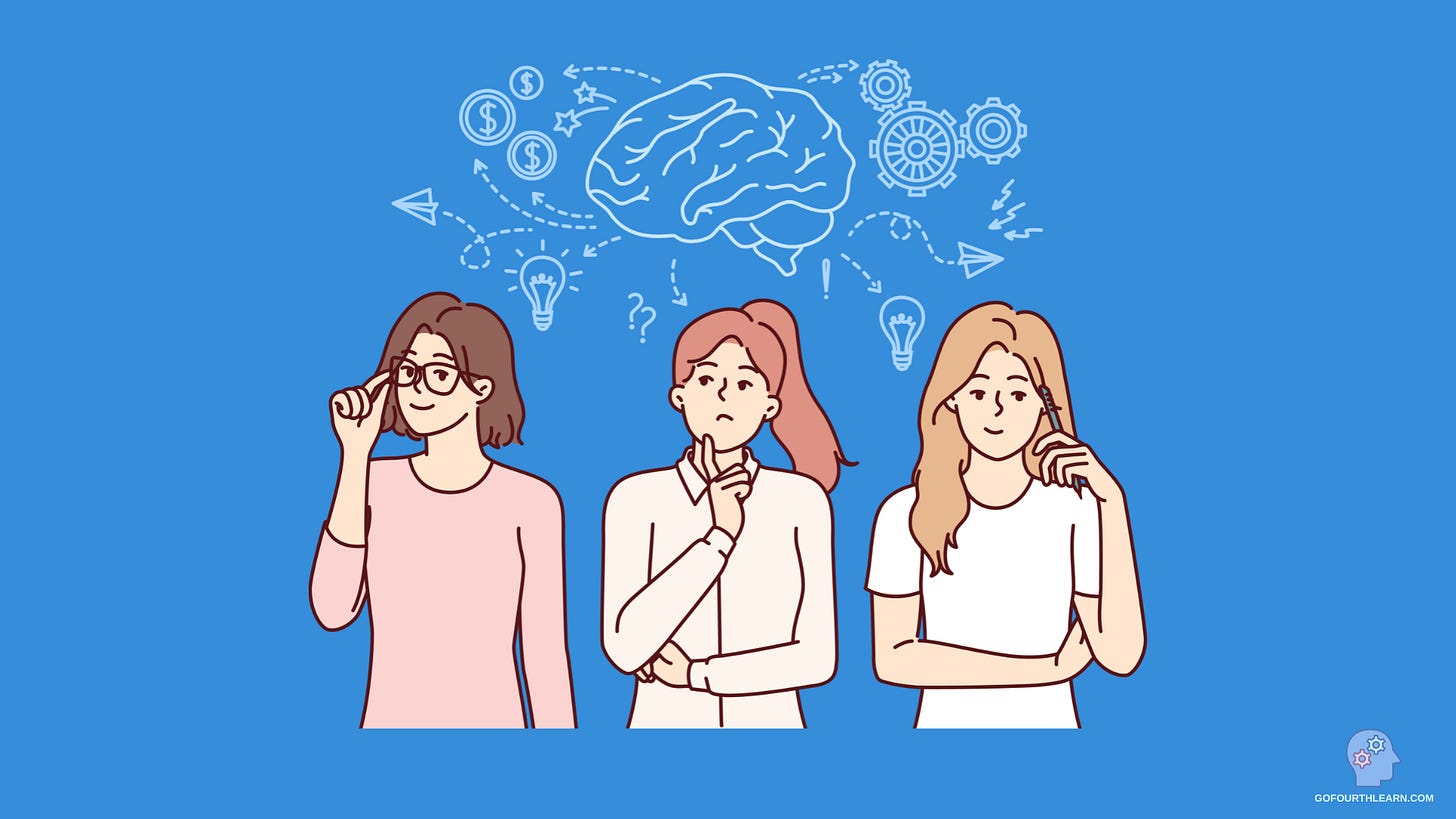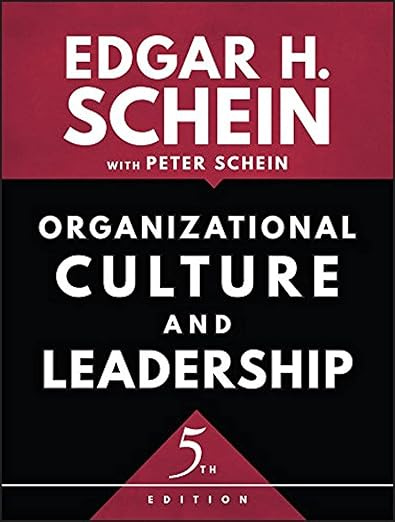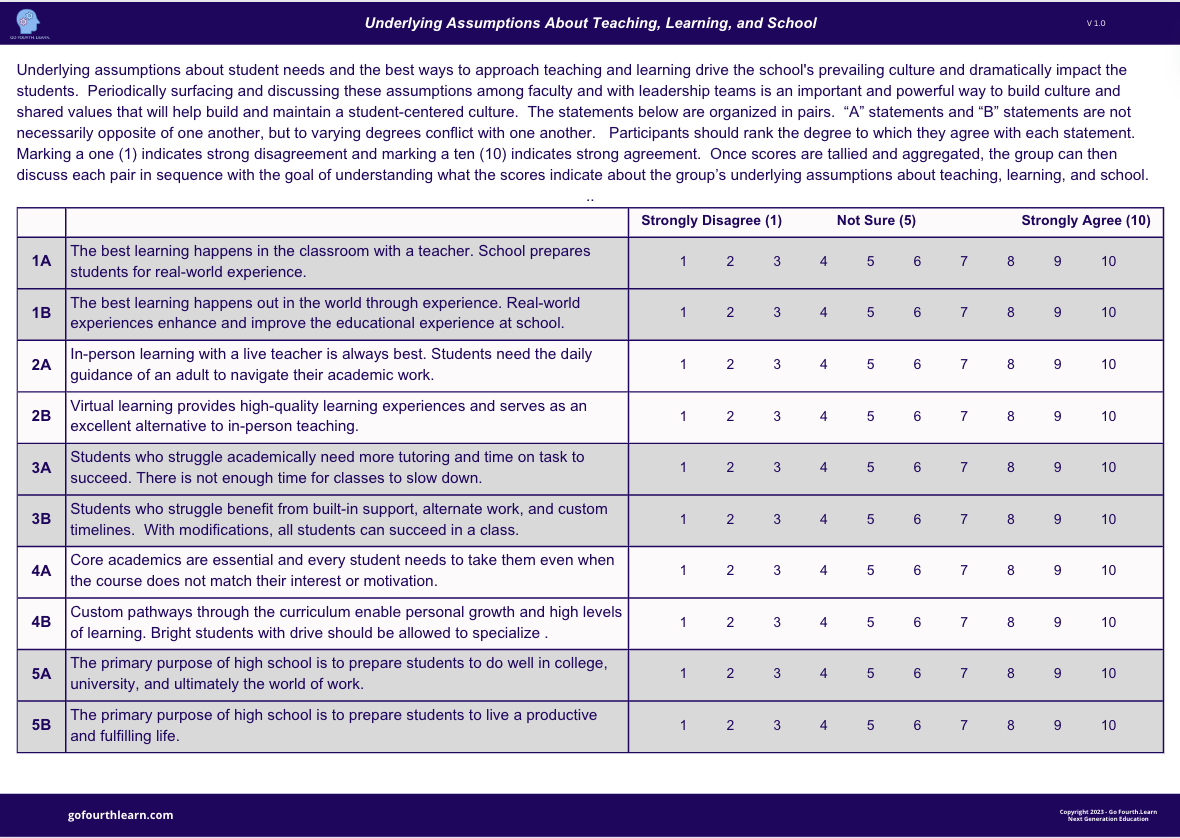Surfacing Underlying Assumptions About Teaching and Learning
In this post:
Collective assumptions about teaching and learning make or break the culture of teaching and learning in school. A key role of the leader is to align the group around a set of underlying assumptions that underpin the day-to-day work of the school.
Ten common assumptions about teaching and learning that school leaders should be discussing with faculty, parents, and community.
A team exercise that school leaders can use for guided discussion around underlying assumptions that will help align the team and surface areas where teams may be aligned or misaligned in their work together.
Underlying Assumptions and Mental Models
As we look to improve secondary schools for today's students, leading change requires examining the assumptions underpinning the ways that schools work. Previous posts on the GFL Lead Leaner Blog have discussed sacred cows and mental models about school. Behind both of these ideas are the underlying assumptions that each member of a teaching faculty or school community has about how school works, or based on those assumptions, how school should work.
Edgar Shein, author of the book Organizational Culture and Leadership, writes that:
"Basic assumptions, like theories-in-use, tend to be nonconfrontable and nondebatable, and hence are extremely difficult to change. To learn something new in this realm requires us to resurrect, reexamine, and possibly change some of the more stable portions of our cognitive structure—a process that Argyris and others have called “double-loop learning,” or “frame breaking” (Argyris et al., 1985; Bartunek, 1984). Such learning is intrinsically difficult because the reexamination of basic assumptions temporarily destabilizes our cognitive and interpersonal world, releasing large quantities of basic anxiety"
Underlying assumptions for individuals are built over time through experiences with the prevailing culture, socialization, and educational experiences. In work settings, underlying assumptions are developed through training programs, mentorship, and years of experience in the workplace. For the transformational leader, identifying and shaping shared underlying assumptions is a key part of the work in gathering momentum around improvement and change initiatives. The goal is to get to shared assumptions that support the goals and objectives around improving learning and the school experience.
According to Shein:
"Leadership is originally the source of the beliefs and values that get a group moving in dealing with its internal and external problems. If what leaders propose works, and continues to work, what once were only the leader’s assumptions gradually come to be shared assumptions."
In schools, the conventional wisdom about what works and what doesn't work in the classroom is built on underlying assumptions that are often stubbornly rooted in personal experiences that educators (and parents) had with their own education. These experiences, rooted in the past, have staying power because of their familiarity and comfort. Many well-intentioned educators who acknowledge the need for the school experience to be different for today's students are pulled back or limited in adopting new ways of working because the underlying assumptions of what is good, and works for students have not been examined at a level of depth in their schools.
The exercise below provides a method for school leaders to open conversations with teachers, parents, students, and other members of their school community around underlying assumptions. The resulting dialogue, contextualized with the internal and external problems that the school is working to resolve, will enable momentum toward shared assumptions that support needed changes.
Ten Underlying Assumptions About Teaching and Learning
Underlying assumptions about student needs and the best ways to approach teaching and learning drive the school's prevailing culture and dramatically impact the students. Periodically surfacing and discussing these assumptions among faculty and with leadership teams is an important and powerful way to build culture and shared values that will help build and maintain a student-centered culture.
The statements below are organized in pairs. “A” statements and “B” statements are not necessarily opposite of one another, but to varying degrees conflict with one another. As part of the discussion exercise, participants should rank the degree to which they agree with each statement. Marking a one (1) indicates strong disagreement and marking a ten (10) indicates strong agreement. Once scores are tallied and aggregated, the group can then discuss each pair in sequence to understand what the scores indicate about the group’s underlying assumptions about teaching, learning, and school.
The paired assumptions are listed below. "A" statements represent commonly held views that leaders may encounter from various constituencies that they work with. "B" statements represent a shift in assumptions that may be more supportive of the work schools are doing as they work to close relevance gaps and create higher levels of student engagement. It is important to emphasize that the paired statements are not intended to oppose one another. Rather, using a ten-point agree/disagree range with participants allows for nuance in the group discussion and the opportunity to work in situations where a school community may value both sets of assumptions in a paired group to varying degrees. While it is not difficult to see a bias in the exercise toward the "B" statements as more desirable, the main point of the exercise is to surface and establish commonality among the group as a starting point for school improvement work.
Assumption #1 - Real World Learning
To what degree do you agree with these statements?
1A - The best learning happens in the classroom with a teacher. School prepares students for real-world experiences.
1B - The best learning happens out in the world through experience. Real world experiences enhance and improve the educational experience at school.
Assumption #2 - Virtual Learning
To what degree do you agree with these statements?
2A - In-person learning with a live teacher is always best. Students need the daily guidance of an adult to navigate their academic work.
2B - Virtual learning provides high-quality learning experiences and serves as an excellent alternative to in-person teaching.
Assumption #3 - Academic Support
To what degree do you agree with these statements?
3A- Students who struggle academically need more tutoring and time on task to succeed. There is not enough time for classes to slow down.
3B - Students who struggle benefit from built-in support, alternate work, and custom timelines. With modifications, all students can succeed in a class.
Assumption #4 - Personalized Paths for Students
To what degree do you agree with these statements?
4C - Core academics are essential and every student needs to take them even when the course does not match their interest or motivation.
4D -Custom pathways through the curriculum enable personal growth and high levels of learning. Bright students with drive should be allowed to specialize.
Assumption #5 - The Purpose of High School
To what degree do you agree with these statements?
5A - The primary purpose of high school is to prepare students to do well in college, university, and ultimately the world of work.
5B - The primary purpose of high school is to prepare students to live a productive and fulfilling life.
Assumption #6 - Content Acquisition vs. Application
To what degree do you agree with these statements?
6A -Students must learn the basics and facts of each discipline as a foundation. Creativity and innovation are nice to have but the basics have to come first.
6B - Teaching students how to learn and apply thinking and reasoning skills is a priority, even if this means focusing on smaller amounts of content in a course.
Assumption #7 - Grades
To what degree do you agree with these statements?
7A - Students are in competition with one another. High grades show that students have outperformed their classmates. Only the best make it to the top.
7B - Our job is to create as many winners as possible. All students can earn high marks. High grades show that students have mastered course content and skills.
Assumption #8 - Capacity to Learn
To what degree do you agree with these statements?
8A - The capacity to learn is a fixed, innate quality that cannot be changed. Our job is to identify, promote, and support talented students.
8B - High-quality learning experiences make the brain “stronger”. The work we do as educators can build the capacity for high-level learning in all of our students.
Assumption #9 - Access to Advanced Curriculum
To what degree do you agree with these statements?
9A - We can predict a student's future capabilities based on past performance. Students with poor grades or poor attitudes will likely not do well in the future.
9B - The ultimate capabilities of a student depend on quality educational experiences. When challenged with advanced study, students will rise to meet expectations.
Assumption #10 - Motivation to Learn
To what degree do you agree with these statements?
10A - Today's students have a lower desire to grow and learn than they did 10-15 years ago. They just don’t seem as motivated and ambitious as in the past.
10B - Today's students are bright curious and motivated. In my experience, the desire to learn and grow has been consistent from generation to generation.
The GFL Underlying Assumptions Excercise
School leaders can access a PDF download of the Underlying Assumptions Exercise here or in the downloads section of the GFL Website.
Leaders working as systems thinkers will remember GFL Modified Deming Point # 2 "Discard the philosophies and mental models associated with industrial schooling" Surfacing and discussing the underlying assumptions about teaching and learning as a regular practice will help actualize that process in schools looking to grow and improve for the next generation of students.
- Dr. Steven Lyng / gofourthlearn.com
References:
Core Education. “232 Innovative Schools Challenging Old Assumptions about Education.” Core Education, LLC, 22 Feb. 2022, www.coreeducationllc.com/blog2/232-innovative-schools-challenging-old-assumptions-about-education/. Accessed 17 Apr. 2024.
Jenkins, Lee. Improving Student Learning: Applying Deming’s Quality Principles in Classrooms. Milwaukee, Wis., ASQ Quality Press, 2003.
Kohn, Alfie. “Moving beyond Facts, Skills, and Right Answers - Alfie Kohn.” Alfie Kohn, 29 Oct. 1999, www.alfiekohn.org/article/moving-beyond-facts-skills-right-answers/.
Langford, David P., and Barbara A. Cleary. Orchestrating Learning with Quality. Milwaukee, Asqc Quality Press, 1995.
Looney, D. Scott. “The Future of Education: Why Hawken Has to Lead by Hawken School - Issuu.” Issuu.com, 4 Aug. 2014, issuu.com/hawkenschool/docs/thefutureofeducation#google_vignette. Accessed 7 Mar. 2024.
Schein, Edgar H. Organizational Culture and Leadership (Jossey-Bass Business & Management Series). Jossey Bass Inc, 2004.
Selingo, Jeffrey. “Opinion: The Myth of the Well Rounded Student? It’s Better to Be T-Shaped.” The Washington Post , 1 June 2016.
Wieman, Carl . “We Must Confront the Assumptions That Have Held Back HE for Centuries.” THE Campus Learn, Share, Connect, 17 Feb. 2022, www.timeshighereducation.com/campus/we-must-confront-assumptions-have-held-back-he-centuries.





